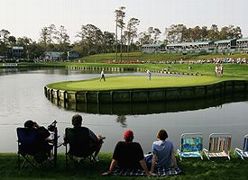|
If the average Joe played the 17th hole at TPC-Sawgrass the way most of the pros will play it this weekend, the water surrounding the most famous island green in golf would be relatively calm. But thanks to duffers who plunk an average of three golf balls per round into the surrounding water, course officials estimate that more than 120,000 balls get wet every year.  It's this hole that makes TPC-Sawgrass the prize among golf ball refurbishers, who usually pay the course a per ball recovery fee, commission divers to salvage balls in golf course water hazards, fix them up and resell them at a hugely discounted rate. "It's probably the most lucrative waters in the entire golf ball business," said Billy Dettlaff, the course's director of golf and general manager. "There are several reasons for this. Playing this course is a once-in-lifetime experience for some people, so they obviously play with the best balls. Combine that with the difficulty of the hole and the fact that everyone wants to hit the green just once." The other secret? The water surrounding the island green is only 4 to 5 feet deep. "Not only is the volume of balls great, but the divers don't have to go too far under water to find the balls," Dettlaff said. The golf ball recovery business can be tremendously profitable. At least 200 million golf balls are lost each year in the United States, with the majority of them being found by divers who have reported annual income in the $50,000 to $100,000 range. "It takes a special person to want to be a golf ball diver," said Dick Smith, owner of Midwest Diving Specialists, a diving school in Normal, Ill., that offers a golf ball diving course. "That person has to love treasure hunting and be extremely testosterone-laden." That's because diving doesn't come without a price. Divers routinely report getting bitten by water moccasins and snapping turtles, and the ultimate impediment to collecting the used golf ball in Florida is the alligator. "When I was diving in Virginia and the Carolinas, I was worried about the turtles, the snakes and the muskrats," said Larry Marcelli, owner of Golf Balls Galore, which takes in more than 2 million golf balls a year from courses in southwest Florida. "Then I got to Florida and all of that flew out the window. Those other animals weren't going to try and eat me." Dettlaff says that divers will find alligators; two 8-foot gators recently were spotted on the 18th hole. But the upper-class golfing clientele -- players who pay between $119 and $257 per round, depending on the time of year -- makes finds in the waters of Sawgrass less interesting than those at some venues. Marcelli says one of his divers found a person sitting at the wheel of a Volkswagen at the bottom of a lake in Fort Myers, Fla. Other reported submerged finds have included handguns, golf carts, a complete set of clubs with a wallet in it, a Barbie doll and a full telephone booth. Four times a year, divers for a company called The Best Balls enter the waters at the TPC-Sawgrass to take out the riches. Dettlaff would not disclose the per ball recovery fee but did say the price was reflective of the quality of the balls usually pulled out. The most coveted ball -- the Titleist Pro V1 -- generally sells for $54 a dozen. But The Best Balls sells the slightly used variety for $18.95. Although some see this as a bargain, golf ball manufacturers are not thrilled. Executives with the top companies have said that washed or recoated balls might look new but that sitting in water for months affects the aerodynamic qualities of the ball. That contention was confirmed by a 1996 Golf Digest study, which reported that the longer a ball was submerged in water, the higher the odds were that it would lose distance. The highest point of tension between golf ball retailers and used ball sellers came three years ago when Acushnet, the owner of the Titleist brand, sued a golf ball refurbishing company, arguing that the company shouldn't have the right to call its used balls Titleist. The U.S. Court of Appeals for the Federal Circuit ruled that although the company, Nitro Leisure Products, reapplied a fresh Titleist logo to the balls, it did disclose sufficiently that the balls were used and refurbished. The ruling was a major victory for the used golf ball business, which has turned into a $200 million industry. No credit for that goes to the pros who will be playing on the Stadium Course this week, however; they will deposit only about 30 balls in the water on the 17th throughout the four-day tournament. Darren Rovell, who covers sports business for ESPN.com, can be reached at Darren.rovell@espn3.com.
|
